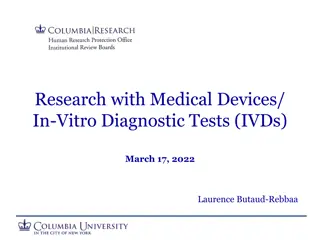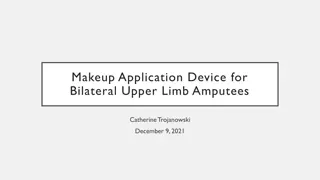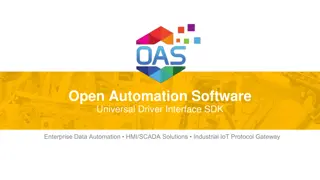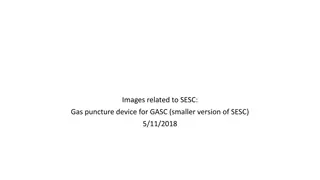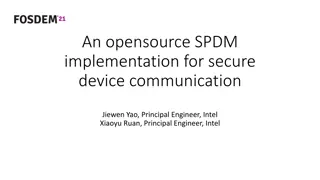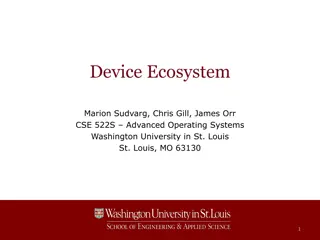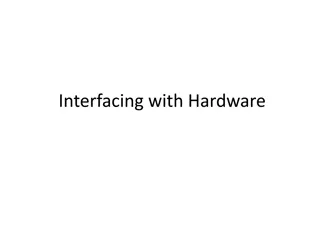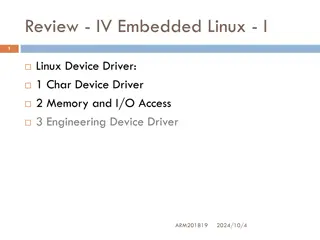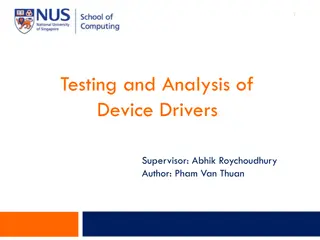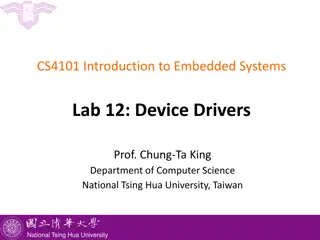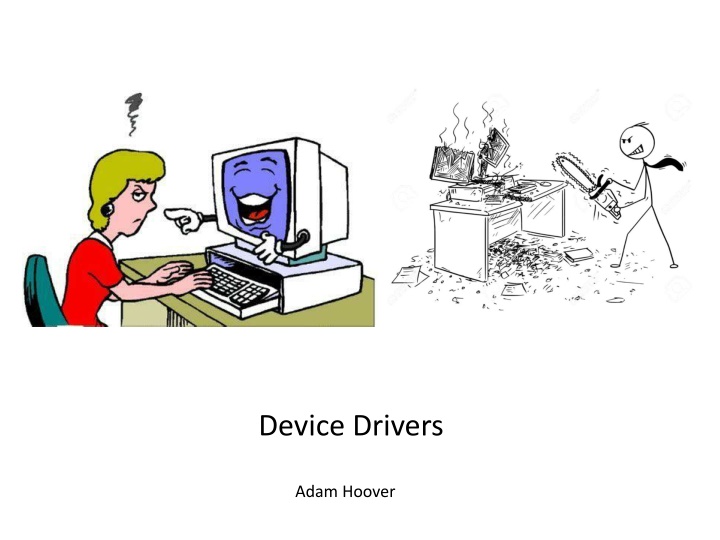
Device Drivers, Hardware Interfaces, and Software Development
Explore the intricacies of device drivers, hardware interfaces, and software development in this comprehensive guide. Learn how hardware and software interact, the role of device drivers in insulating developers from hardware details, the design philosophy treating hardware like files, and the functions developers write to facilitate communication between applications and hardware. Discover the file management system of the operating system and how developers can manipulate functions for data transfer, setup, cleanup, and more.
Download Presentation

Please find below an Image/Link to download the presentation.
The content on the website is provided AS IS for your information and personal use only. It may not be sold, licensed, or shared on other websites without obtaining consent from the author. If you encounter any issues during the download, it is possible that the publisher has removed the file from their server.
You are allowed to download the files provided on this website for personal or commercial use, subject to the condition that they are used lawfully. All files are the property of their respective owners.
The content on the website is provided AS IS for your information and personal use only. It may not be sold, licensed, or shared on other websites without obtaining consent from the author.
E N D
Presentation Transcript
Device Drivers Adam Hoover
Hardware interface application device driver Interface between applications and hardware hardware
Software development application standardized interface across different hardware application developer does not need to worry about hardware details device driver developer (manufacturer) insulates hardware device driver device driver device driver
Design philosophy all hardware treated like files each piece of hardware gets its own filename hardware accessed using file-like functions (open, read, etc.) /dev/usb1 /dev/hda /dev/lp
Device driver functions device driver developer writes a set of functions: struct file_operations driver_fops = { read(), open(), close(), write(), seek(), } structure of function pointers provided to O/S driver: application: O/S driver_fops->open() FILE *fpt; fpt=fopen( /dev/hda , r );
Device driver functions struct file_operations driver_fops = { read(), open(), close(), mmap(), ioctl(), write(), seek(), } /* data transfer */ /* setup */ /* cleanup */ /* provide access to driver memory */ /* control */ /* data transfer */ device driver developer can put any code in any function typically open/close handle setup/cleanup typically read/write handle data transfer ioctl (i/o control) is handyman for everything else
O/S file management normal file (ls -al): -rw-r--r-- ahoover cuuser 6796 Sep 2 2019 index.html last mod date permissions (user, group, all) (read, write, exec) file size (bytes) owner filename group device files (ls -al): brw-rw---- root disk 8, 0 Aug 24 2019 brw-rw---- root disk 8, 1 brw-rw---- root disk 8, 16 brw-rw---- root disk 8, 17 crw-rw---- root disk 21, 0 crw-rw---- root disk 21, 1 sda sda1 sdb sdb1 sg0 sg1 Aug 24 2019 Aug 24 2019 Aug 24 2019 Aug 24 2019 Aug 24 2019 driver file b => block c => character minor number manage multiple copies major number which set of functions to use
Creating a device file To make a device filename, run the mknod command: mknod m660 /dev/sg0 c 21 0 b => block c => character major number minor number permissions crw-rw---- root disk 21, 0 Aug 24 2019 sg0 Device filenames can be removed using the standard rm command
Providing driver code to O/S Driver code can be compiled into the kernel: make bzImage kgcc kernel.c kgcc driver.c /boot/vmlinuz.img The kernel file will contain the functions within driver.c and be ready to use them upon booting.
Dynamically add driver to O/S Driver code can be dynamically linked into the kernel: gcc driver.c driver.o insmod driver.o (dynamically linked) The kernel can be updated with new code using the insmod command. This can be done while the kernel is currently running.
O/S module management Driver developer writes functions for module insertion and removal: insmod driver.o module_init() (setup, informs O/S of major number) rmmod driver.o module_exit() (cleanup, removal) lsmod (see list of all modules currently linked and in use) These functions are included in the driver.c file.
Writing the driver struct file_operations driver_fops = { read(), open(), close(), mmap(), ioctl(), write(), seek(), } /* up to you */ /* up to you */ /* up to you */ /* up to you */ /* up to you */ /* up to you */ /* */ different for every piece of hardware usually a mix of C and assembly read spec sheet (manual) from manufacturer provide useful interface to application developers
When everything works correctly Users and application developers all benefit from good device drivers.


